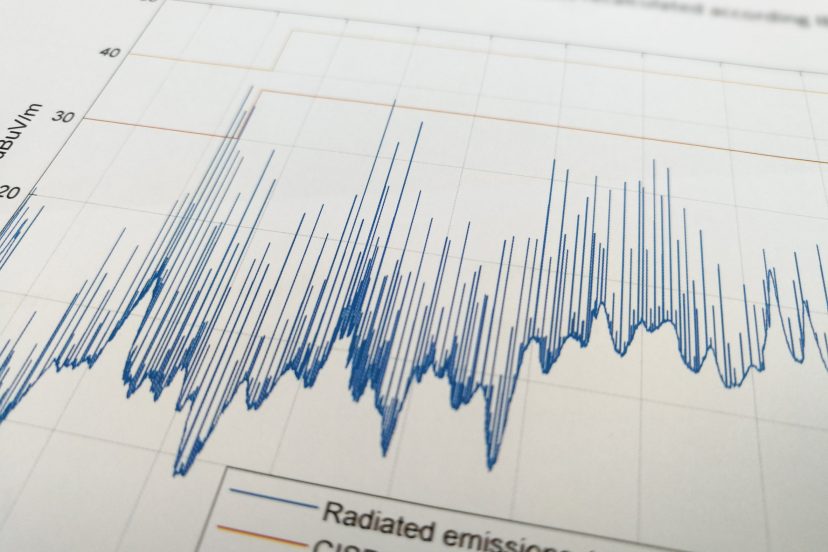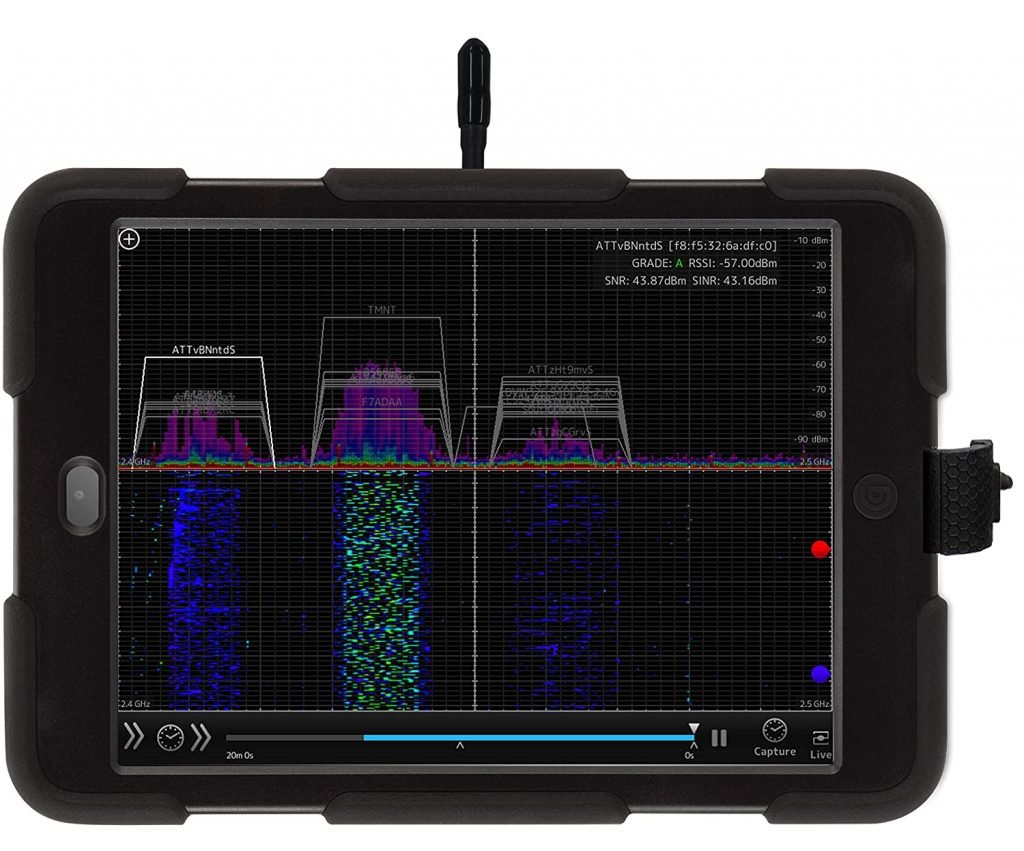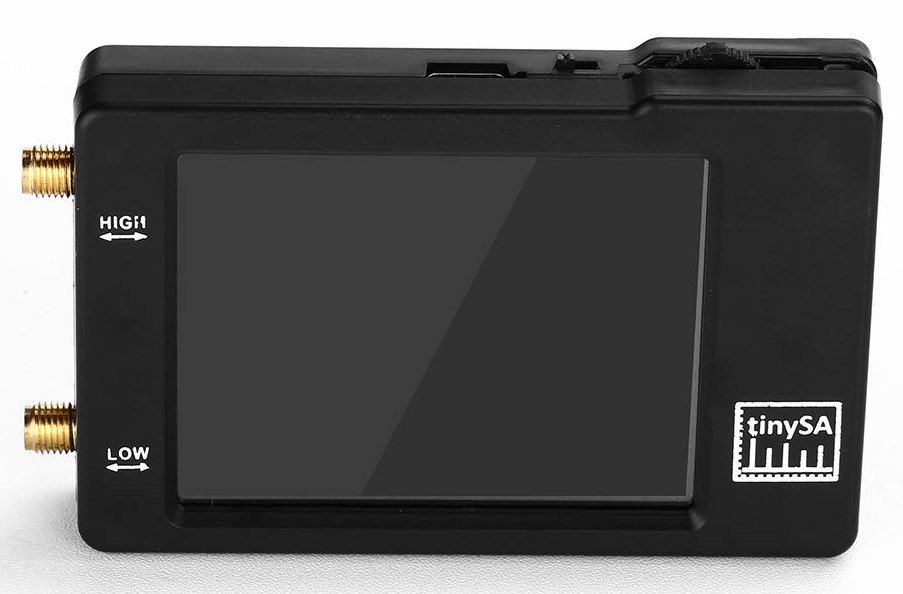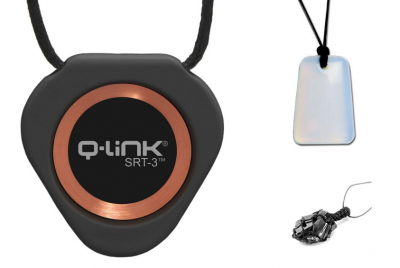When worn correctly, both Bluetooth and wired earbuds offer a lightweight and comfortable way to listen…
What An RF Spectrum Analyzer Does and Top Models

*We may earn a commission for purchases made using our links. Please see our disclosure to learn more.
If you are concerned about EMF radiation in your home, you may have invested in an EMF meter. These are devices that show you the strength of electromagnetic frequencies in a given area. This is quite useful, but it doesn’t tell you exactly what frequencies are present. Is there a device that could do such a thing?
It turns out, there is. RF spectrum analyzers are routinely used by EMF inspectors and others who need to gather specific and detailed information about the radiofrequencies in a given area.
So what, exactly, is an RF spectrum analyzer? Should you consider buying one of your own?
What is an RF spectrum analyzer?
Before you decide if a spectrum analyzer is your next purchase, let’s learn a little about what these devices do.
For starters, recall that RF stands for radiofrequency. On the electromagnetic spectrum, radiofrequency waves fall on the non-ionizing side of things. Radiofrequency waves range from anywhere between 20 kHz to 300 GHz.
An RF spectrum analyzer’s function is very true to its name — they literally analyze frequencies inside the RF range. These units contain an antenna that listens to a designated range of frequencies, although the exact range varies by model. When a spectrum analyzer detects an RF signal, it first attenuates the frequency and passes it through a few different filters. These filters help bring the desired frequency to the forefront and remove some of the higher and lower surrounding ones — getting rid of white noise, basically.
In general, there are three types of spectrum analyzers and after the initial signal detection and filtering process, they all behave in different ways. The types are:
- Swept Spectrum Analyzer (SA)
- Vector Signal Analyzer (VSA)
- Real-Time Spectrum Analyzer (RSA)
An SA is the most basic of all spectrum analyzers. With an SA, once the frequency has gone through the initial filters, it is then downconverted and additional filtering is applied. The device then calculates the amplitude (or strength) of the resulting frequency. These units are useful for measuring the strength of a consistent frequency, although it’s worth noting that they can only focus on one frequency at a time.
The next type of analyzer, the VSA, follows a very similar process. The primary difference is that the VSA digitizes the frequency and stores it in the device’s memory. Similarly to an SA, however, VSAs are most useful when looking at consistently present frequencies. It is difficult to measure frequencies that are more sporadic with a VSA.
RSAs, the last type of analyzer, measure RF signals in real-time. If it helps, think of a VSA and an SA as a camera that can capture still images only, while an RSA can stream video live. RSAs do also digitize the frequency and store it to memory, but they have the added benefit of being able to look at the full range of frequencies present instead of focusing solely on one. It is also true that because of their ability to listen over a period of time, RSAs are more useful for capturing signals that may not occur constantly.
Spectrum analyzers and EMF radiation
At this point, you have a better understanding of what an RF spectrum analyzer does and how they work. What may not be clear, however, is why you would use one.
The reality is, spectrum analyzers have a variety of uses, even outside of EMF detection. They can help detect interfering RF signals, for example, and aid in testing telecommunications and radar equipment. They are quite common in an industrial setting, especially where radiofrequencies are involved.
From a consumer standpoint, spectrum analyzers can help you listen to the specific signals present in your home, determining the exact frequencies and strength. Furthermore, they can detect a wider range of frequencies than most EMF meters. This is especially helpful for those who are concerned about 5G millimeter wave towers, which produce frequencies ranging from 29 to 34GHz — something much higher than the average EMF meter can measure.
Purchasing a spectrum analyzer
If you’d like to try out an RF spectrum analyzer for yourself, there are a few things you should keep in mind. For one, consider what range of frequencies you want to be able to measure, and make sure the unit you choose falls within that. Also, set a budget. Spectrum analyzers are usually commercial devices, and they tend to come with a higher price tag than your standard EMF meter. EMF meters with built-in spectrum analyzers are available (and, in fact, we’ll talk about one below,) but they may not be able to measure the full range that an industrial device can.
Finally, determine in advance which type of analyzer would be the most useful for you. Real-time analyzers are arguably going to be the most beneficial, but also may be more expensive.
Top spectrum analyzer models

5. Oscium WiPry 2500x WiFi Spectrum Analyzer. This heavy duty RF spectrum analyzer works with 2.4Ghz and 5GHz frequencies. Because of that, you aren’t able to find millimeter wave 5G signals with this device, but you can still look at WiFi and Bluetooth signals from cell phones, TVs, microwaves, baby monitors, and other devices. This can also give you an idea of what frequencies from nearby 4G (or low and mid-band 5G0 cell towers are reaching your home, as well. Oscium’s spectrum analyzer pairs with your cell phone (Android or iPhone) or desktop (Windows or Mac). Using their app, you can access the WiPry’s detailed report about the RF signals it detected, and unlike some other devices, there is no separate software subscription required. This isn’t a bad spectrum analyzer by any means, but the price is a little on the high side, particularly if you aim to use it for EMF detection and awareness.

4. Rohde & Schwarz Spectrum Rider FPH Handheld Spectrum Analyzer. This RF spectrum analyzer, from high-end manufacturer Rohde & Schwarz, is commercial-grade, compact, and portable. It’s one of the more affordable options available from Rohde & Schwarz, but that doesn’t make it cheap. Rugged, durable, and lightweight, the .26 model of the Spectrum Rider can measure frequencies ranging from 5 KHz to 31 GHz. This analyzer is highly sensitive and capable of detecting weak RF signals, and if you require extreme sensitivity, there is the option to upgrade to a pre-amplifier. Other Spectrum Rider features include a backlit keyboard, a smartphone-like touchscreen interface, and a non-reflective screen that is easy to see in the sun. The accompanying holster and side harness also allow for convenient, hands-free operation.

3. EMRSS RF Explorer 6G Combo. If you’re looking for something a little more budget-friendly without sacrificing quality, the RF Explorer is a solid mid-range option. This spectrum analyzer weighs just 6.5 ounces, and comes with a small, hardshell carrying case for safer transport. It is battery-powered, running on a single lithium ion battery, which is sold with the device. The RF Explorer connects to your PC using a mini-USB cord, at which point you can use the accompanying software to analyze your data. As far as frequencies go, the RF Explorer can detect a wide range of radiofrequencies using its wideband telescopic antenna, ranging from under 1 GHz to the 5.8 GHz band.

2. Seesii Portable Tiny Spectrum Analyzer. This tiny and affordable spectrum analyzer from Seesii can literally fit in the palm of your hand. That doesn’t, however, mean it isn’t powerful. Seesii’s spectrum analyzer can detect frequencies ranging from 100KHz to 960MHz with four different display modes. This device isn’t particularly useful for WiFi or 5G, but for lower frequencies it works quite well. The spectrum analyzer can also be connected to your computer via USB cable, where both Linux and Windows computers can make use of the accompanying software. Make note, however, that the software does not work with Mac devices.

1. GQ EMF Meter with Data Logger and Spectrum Analyzer. We mentioned earlier that some EMF meters have built-in spectrum analyzers, and the time has now come to talk about which one. GQ’s EMF-390 is a highly sensitive EMF meter that can detect magnetic and electric fields as well as radiofrequencies up to 10 GHz. Again, not useful for high-band 5G, but it works for most other applications. Best of all, this meter has a built-in RF spectrum analyzer that can measure five bands up to 2.5 GHz. GQ’s meter can be connected to your computer using USB, but this is primarily used for charging as the real-time spectrum analysis graph is displayed on the device itself. If you want a spectrum analyser for EMF purposes, this is probably your best option, both because of affordability and overall practicality of the device.
Final thoughts
A spectrum analyzer can help you determine exactly what radio frequencies are present in your home, as well as their strength. Once you know what’s there, it is important to then do something with that information. Ideally, use it to make changes around your home, as that will ultimately reduce your EMF exposure.
For more information on things you can do once you know what EMF radiation is present in your house, head over to Whole House EMF Protection: The Definitive Guide.



